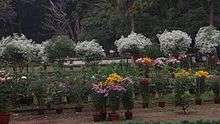Santiniketan
| Shantiniketan শান্তিনিকেতন | |
|---|---|
| Town | |
|
Shantiniketan's Annual Poush Mela | |
 Shantiniketan শান্তিনিকেতন | |
| Coordinates: 23°41′N 87°41′E / 23.68°N 87.68°ECoordinates: 23°41′N 87°41′E / 23.68°N 87.68°E | |
| Country | India |
| State | West Bengal |
| District | Birbhum |
| Languages | |
| • Official | Bengali, English |
| Time zone | IST (UTC+5:30) |
| Lok Sabha constituency | Bolpur |
| Vidhan Sabha constituency | Bolpur |
| Website |
shantiniketan |
Shantiniketan (Bengali: শান্তিনিকেতন Shantiniketôn) is a small town near Bolpur in the Birbhum district of West Bengal, India, approximately 160 km north of Kolkata (formerly Calcutta). It was established by Maharshi Devendranath Tagore, and later expanded by his son Rabindranath Tagore whose vision became what is now a university town, Visva-Bharati University.[1]
History
Shantiniketan was earlier called Bhubandanga (named after Bhuban Dakat, a local dacoit), and was owned by the Tagore family. In 1862, Maharshi Devendranath Tagore, while on a boat journey to Raipur, came across a landscape with red soil and meadows of lush green paddy fields. Rows of chhatim trees and date palms charmed him. He stopped to look, decided to plant more saplings and built a small house. He called his home Shantiniketan (abode of peace). Shantiniketan became a spiritual centre where people from all religions were invited to join for meditation and prayers. He founded an 'Ashram' here in 1863 and became the initiator of the Brahmo Samaj.
Here Rabindranath Tagore started Patha Bhavana, the school of his ideals, whose central premise was that learning in a natural environment would be more enjoyable and fruitful. After he received the Nobel Prize (1913), the school was expanded into a university in 1921. By 1951, it had become one of India's central universities.
Notable people
- Amartya Sen, the 1998 Nobel Prize winner in economics, studied at Patha Bhavana
Geography
Shantiniketan is at 23°41′N 87°41′E / 23.68°N 87.68°E.[2] It has an average elevation of 56 metres (187 feet).
Climate
- Temperature (deg C): Summer — max. 42.4, min. 34.3; Winter — max. 15.7, min. 8.1.
- Rainfall: 125 cm (June to September). Heavy in July and August.
Shantiniketan can be visited at any time of the year. The climate is moderately warm, with summer temperatures at around 34-45 °C and winter at 8-15 °C. July and August see heavy rainfall.
Major events
Social and cultural events take place throughout the year. These include Basanta Utsav, Barsha Mangal, Sharodutsav, Nandan Mela, Poush Mela, Magh Mela, Rabindra Jayanti to name a few.
Of these, the Poush Mela is a major tourist attraction. It is a three-day fair (Bengali, mela means a fair), starting on the seventh day of the Bengali month Poush (usually, last week of December). It fetches tourists,artisans, folk singers, dancers, and the traditional Baul from the neighbourhood.
Gardens and parks at Shantiniketan


There is a Deer Park 3 km from Shantiniketan. Originally, the area was a fast eroding 'Khowai'. It is now a large wooded area with herds of deer and makes a natural bird sanctuary.
Transport
- Trains direct to Bolpur from Howrah and Sealdah station.
- Bus from Durgapur City Centre Bus Stop and Dharmatala Bus Stop (Soon to shifted to near Santragachi Railway Station) in Kolkata is also available for Bolpur/Shantiniketan.
See also
References
- ↑ Pearson, WW.: Shantiniketan Bolpur School of Rabindranath Tagore, illustrations by Mukul Dey, The Macmillan Company, 1916
- ↑ Falling Rain Genomics, Inc - Shantiniketan
External links
| Wikimedia Commons has media related to Santiniketan. |
- Official Shantiniketan website
-
 Santiniketan travel guide from Wikivoyage
Santiniketan travel guide from Wikivoyage
